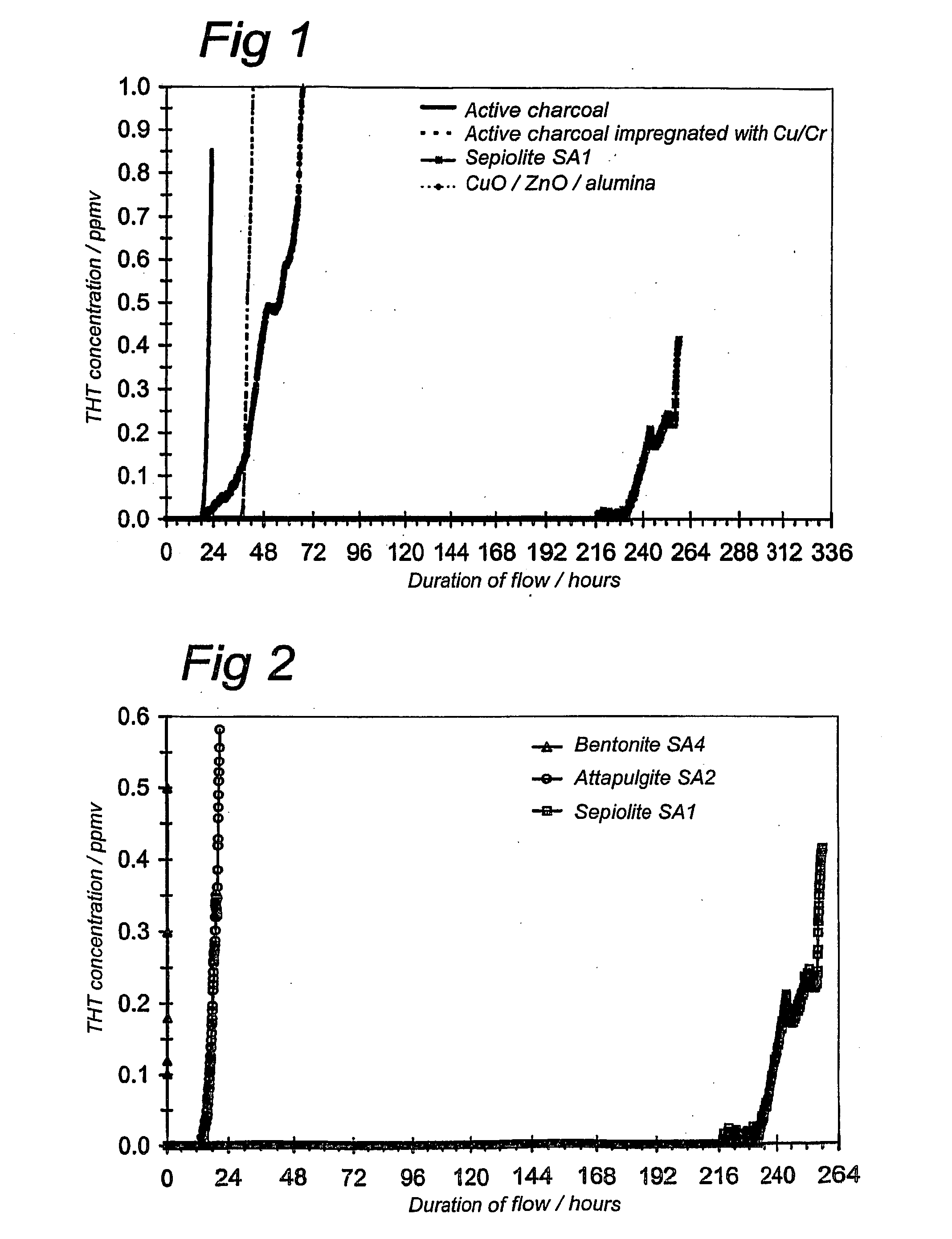Method for desulphurisation of natural gas
a natural gas and desulphurisation technology, applied in the field of desulphurisation of natural gas, can solve the problems of odorant such as tht in natural gas so low, and the adsorption capacity of such adsorbents is so low
- Summary
- Abstract
- Description
- Claims
- Application Information
AI Technical Summary
Problems solved by technology
Method used
Image
Examples
example 1
[0071] In this example sepiolite (obtainable as dust-free cat litter granules; >80% (m / m) sepiolite and <20% (m / m) zeolite) is compared with various common adsorbents such as active charcoal (Norit, code RB1; peat-based, steam-activated, extruded, not impregnated); active charcoal impregnated with copper and chromium (Norit, code RGM1; peat-based, steam-activated and impregnated); and copper oxide / zinc oxide / alumina (BASF R3-12; metal / metal oxide). The sepiolite of the present invention is able to bind the most sulphur.
TABLE 1List of samples tested and test conditions for Examples 1 and 2Adsorbent tested:Active charcoal,Active charcoal impregnated withcopper and chromium,Copper oxide / zinc oxide / alumina,SepioliteVolume of adsorbent bed:70 mlWeight of adsorbent bed:27-75 gParticle size:1-3 mmGas flow rate:3 l / min(standard temperatureand pressure: 20° C.; 1 atm.)Superficial linear gas velocity10 cm / secTemperature of adsorbent bed:16° C.-25° C.(ambient temperature)Pressure of adsorben...
example 2
[0075] In this example sepiolite (as in Example 1) is compared, under the same conditions as in Example 1, with attapulgite (baked clay granules, 85% (m / m) attapulgite for cat litter from Tijssen, Hazerswoude, The Netherlands) and bentonite (cat litter granules, lump-forming-coarse), which is also a naturally occurring clay mineral. These materials can be obtained from grocery stores and the like.
[0076] It can be seen the comparison of these materials as well, see FIG. 2, that sepiolite (sample SA1) is able to adsorb much more sulphur than the bentonite (sample SA4) and attapulgite (sample SA2).
Test Equipment and Test Conditions for Example 3-6
[0077] The adsorption experiments were carried out in a manually operated flow set-up that was connected via two open / shut taps and an outflow protective device (needle valve) to the 100 mbar(o) (o=overpressure) natural gas supply network. A (cylinder) gas can also be connected via this connection, as desired. The set-up is also connected v...
examples 3-5
Impregnation With Copper
[0086] An amount of 25 g sepiolite of particle size 0.5-1.0 mm was weighed out accurately and placed in a glass beaker. In the case of a so-called ‘dry impregnation’ (incipient wetness) this amount of sepiolite can adsorb a maximum of approximately 40 ml water. 1.57 g copper acetate was then weighed out and dissolved in approximately 40 ml demineralised water in a glass beaker with the aid of vibration at room temperature in an ultrasonic vibration bath for approximately 10 minutes. The sepiolite was then impregnated with the resulting solution by means of dry impregnation. After brief manual stirring, the impregnated sepiolite was dried in air for a minimum of 24 hours in a drying oven at 40° C. The material dried in this way contains approximately 2% (m / m) Cu2+ and is ready for use for adsorption determinations. A sample containing 5% (m / m) Cu2+ was prepared in the same way as described above.
Results
[0087] The capacities determined for adsorption of the...
PUM
| Property | Measurement | Unit |
|---|---|---|
| Temperature | aaaaa | aaaaa |
| Temperature | aaaaa | aaaaa |
| Mass | aaaaa | aaaaa |
Abstract
Description
Claims
Application Information
 Login to View More
Login to View More - R&D
- Intellectual Property
- Life Sciences
- Materials
- Tech Scout
- Unparalleled Data Quality
- Higher Quality Content
- 60% Fewer Hallucinations
Browse by: Latest US Patents, China's latest patents, Technical Efficacy Thesaurus, Application Domain, Technology Topic, Popular Technical Reports.
© 2025 PatSnap. All rights reserved.Legal|Privacy policy|Modern Slavery Act Transparency Statement|Sitemap|About US| Contact US: help@patsnap.com

